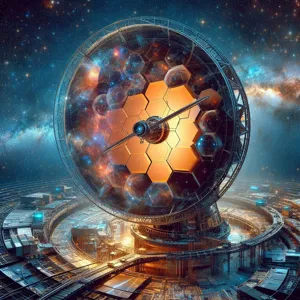As humanity stands on the precipice of astronomical discovery, the James Webb Space Telescope (JWST) emerges as our most powerful ally in unlocking the secrets of the universe.
Launched with the promise of expanding our understanding of the cosmos, this revolutionary observatory is designed to peer deeper into space and time than ever before, offering unprecedented insights into the birth of stars, the formation of galaxies, and the potential for life beyond our planet. With its advanced infrared technology, the JWST allows scientists to observe celestial phenomena obscured by dust and distance, revealing a tapestry of cosmic wonders that were once beyond our reach. In this blog post, we will explore the transformative role of the James Webb Space Telescope, highlighting its groundbreaking discoveries and the profound impact it has on our quest to understand the universe and our place within it. Join us on this enlightening journey as we delve into the marvels of the cosmos, guided by the lens of this extraordinary instrument.
1. Introduction: The Dawn of a New Era in Astronomy

The James Webb Space Telescope (JWST) represents a monumental leap forward in our quest to understand the cosmos. Launched in December 2021, this groundbreaking observatory is designed to peer deeper into the universe than ever before, unraveling the mysteries of the cosmos with unprecedented clarity and detail. As the most powerful space telescope to date, JWST is a testament to human ingenuity, combining cutting-edge technology with innovative engineering to explore the far reaches of space and time.
This new era in astronomy is marked by JWST’s ability to observe the universe in infrared wavelengths, allowing it to penetrate the cosmic dust clouds that often obscure our view of celestial phenomena. From the formation of stars and galaxies to the potential for life on distant exoplanets, the scope of JWST’s mission is as vast as the universe itself. It promises to answer age-old questions about the origins of the universe, the nature of dark matter, and the evolution of galaxies, all while igniting a sense of wonder and curiosity about the cosmos.
In this blog post, we will embark on a journey through the transformative role of the James Webb Space Telescope, exploring its innovative technologies, monumental discoveries, and the profound impact it is set to have on our understanding of the universe. Join us as we unlock the secrets of the cosmos and witness the dawn of a new era in astronomical exploration.
2. The Vision Behind the James Webb Space Telescope
The vision behind the James Webb Space Telescope (JWST) is as expansive as the cosmos it aims to explore. Born from a collaboration between NASA, the European Space Agency (ESA), and the Canadian Space Agency (CSA), the JWST is designed to be the premier observatory of the next decade and beyond. This ambitious project was conceived with a singular purpose: to delve deeper into the universe than ever before, uncovering the secrets of its origins, evolution, and potential future.
At the heart of this vision is the desire to answer fundamental questions about the cosmos. How did galaxies form and evolve? What are the conditions for life beyond Earth? The JWST serves as a powerful time machine, allowing astronomers to observe light that has traveled billions of years across the universe, giving them a glimpse into its infancy. It operates primarily in the infrared spectrum, enabling it to peer through cosmic dust and gas clouds that obscure visible light, revealing hidden stars, planets, and galaxies.
The design of the JWST reflects this ambitious vision. Its massive 6.5-meter primary mirror, composed of 18 hexagonal segments, is the largest ever launched into space. This mirror collects light from distant celestial objects with unprecedented sensitivity and resolution. Coupled with sophisticated instruments that can analyze the chemical composition of distant atmospheres, the telescope is poised to advance our understanding of exoplanets and their potential habitability.
Furthermore, the JWST’s location at the second Lagrange point (L2), about a million miles from Earth, allows it to maintain a stable environment, minimizing interference from our planet’s atmosphere and light. This strategic position, combined with its advanced technology, ensures that the telescope will provide clearer and more detailed images than its predecessor, the Hubble Space Telescope.
Ultimately, the vision behind the James Webb Space Telescope is not just about observing the cosmos; it’s about connecting humanity to the universe in profound ways. As the JWST embarks on its journey, it invites us to ponder the mysteries of existence and our place within the vast expanse of space. Through its groundbreaking discoveries, the JWST promises to inspire generations of scientists, thinkers, and dreamers, unlocking new realms of knowledge and understanding in our quest to explore the universe.
3. Key Features and Technologies of JWST

The James Webb Space Telescope (JWST) represents a monumental leap forward in our quest to unveil the secrets of the cosmos. Packed with cutting-edge technologies and innovative features, it is designed to push the boundaries of what we know about the universe. One of the most remarkable aspects of JWST is its large primary mirror, measuring an impressive 6.5 meters in diameter. Composed of 18 hexagonal segments made from beryllium and coated with a thin layer of gold, this mirror is optimized for capturing infrared light, allowing it to peer through cosmic dust and gas clouds that often obscure our view of celestial objects.
At the heart of JWST’s functionality is its suite of four sophisticated scientific instruments: the Near Infrared Camera (NIRCam), the Near Infrared Spectrograph (NIRSpec), the Mid-Infrared Instrument (MIRI), and the Fine Guidance Sensor/Near InfraRed Imager and Slitless Spectrograph (FGS/NIRISS). Each instrument is meticulously calibrated to analyze different wavelengths of light, enabling scientists to study everything from the formation of stars and planets to the atmospheres of exoplanets and the early universe’s faintest galaxies.
Another essential feature is JWST’s sunshield, which is roughly the size of a tennis court when fully deployed. This five-layered shield protects the telescope from the heat of the Sun, Earth, and Moon, ensuring that its instruments remain at the frigid temperatures required for optimal performance. By maintaining a stable thermal environment, the sunshield allows JWST to collect incredibly delicate infrared signals that would otherwise be drowned out by thermal noise.
JWST’s ability to operate in the cold vacuum of space is further enhanced by its location at the second Lagrange point (L2), a stable point approximately 1.5 million kilometers from Earth. This strategic positioning not only provides a clear and uninterrupted view of the universe but also minimizes the interference from our planet’s atmosphere, making it an ideal platform for astronomical observations.
In essence, the James Webb Space Telescope is not just a marvel of engineering; it is a beacon of discovery, poised to unlock the mysteries of the universe and transform our understanding of the cosmos. With its advanced features and innovative technologies, JWST is set to embark on an extraordinary journey, revealing the grandeur of the universe as never before.
4. Comparing JWST to Its Predecessor: Hubble Space Telescope
When we think of space exploration and astronomical discoveries, the Hubble Space Telescope often comes to mind as a groundbreaking instrument that has reshaped our understanding of the universe since its launch in 1990. However, as we stand on the brink of a new era in astronomical observation with the James Webb Space Telescope (JWST), it’s fascinating to compare the capabilities and contributions of these two monumental telescopes.
The Hubble Space Telescope operates primarily in the visible and ultraviolet wavelengths, allowing it to capture stunning images of celestial objects, such as distant galaxies, nebulae, and supernovae. Its observations have provided unparalleled clarity and detail, revealing the intricate beauty of the cosmos. Hubble’s legacy includes the discovery of the accelerating expansion of the universe and the identification of exoplanets through transit photometry, but its capabilities are limited when it comes to observing objects obscured by cosmic dust.
Enter the James Webb Space Telescope, designed to complement and expand upon Hubble’s foundational work. JWST operates primarily in the infrared spectrum, which allows it to peer through those very dusty regions of space where stars and planetary systems are born. This ability to see through the dust opens up an entirely new realm of exploration, enabling astronomers to study the formation of stars, the atmospheres of exoplanets, and even the distant light from the first galaxies formed in the early universe.
While Hubble has given us breathtaking visuals, JWST promises to uncover secrets hidden from view, probing deeper into the universe’s history and the origins of galaxies, stars, and potentially life itself. With its advanced instruments and larger mirror, JWST can collect more light and produce images with greater sensitivity, allowing for observations of objects billions of light-years away with unprecedented detail.
In essence, while Hubble laid the groundwork and transformed our understanding of the universe, JWST is poised to take that knowledge to new heights, unlocking mysteries that have eluded us for decades. Together, these telescopes form a powerful duo in the quest to unravel the complexities of the cosmos, each contributing uniquely to our celestial narrative. As we await JWST’s revelations, the synergy between these two titans of astronomy continues to inspire wonder and curiosity about the universe we inhabit.
5. The Science Goals of the James Webb Space Telescope

The James Webb Space Telescope (JWST) represents a monumental leap forward in our quest to unravel the mysteries of the universe. With its suite of advanced instruments and unparalleled sensitivity, the JWST is poised to tackle some of the most profound questions in astrophysics, cosmology, and planetary science. Its science goals are as ambitious as they are diverse, aiming to transform our understanding of the cosmos.
One of the primary objectives of JWST is to explore the formation and evolution of galaxies. By observing the earliest galaxies formed after the Big Bang, scientists hope to gain insights into how these massive structures evolved and merged over billions of years. This endeavor will not only help us trace the history of our own Milky Way but also shed light on the processes that govern galaxy formation across the universe.
In addition to galactic studies, JWST is set to delve into the life cycles of stars. With its ability to peer through cosmic dust, the telescope will observe star formation in unprecedented detail, revealing the intricate processes that give rise to new stars and planetary systems. This includes studying the remnants of massive stars, such as supernovae, and the formation of nebulae, which are the building blocks for new stellar bodies.
The search for exoplanets and the study of their atmospheres is another cornerstone of JWST’s mission. By analyzing the light spectra of distant planets, scientists aim to identify key chemical signatures that may indicate the presence of water, methane, and other life-sustaining compounds. This groundbreaking work could pave the way for the discovery of habitable environments beyond our solar system, fundamentally altering our understanding of life’s potential in the universe.
Moreover, JWST will investigate the nature of dark matter and dark energy, two of the most enigmatic components of our universe. By mapping the distribution of dark matter and observing its effects on galaxy formation and movement, the telescope will provide critical data to help scientists understand these elusive phenomena, which together account for approximately 95% of the cosmos.
Ultimately, the science goals of the James Webb Space Telescope represent a bold and transformative agenda that promises to enhance our comprehension of the universe. As JWST captures stunning images and data from the far reaches of space, it will not only answer longstanding questions but also inspire a new generation of astronomers and enthusiasts to continue exploring the vastness of the cosmos. With its unparalleled capabilities, the JWST is truly a beacon of discovery, unlocking the secrets of the universe one observation at a time.
6. Exploring the Birth of Stars and Galaxies
The James Webb Space Telescope (JWST) has opened a remarkable window into the cosmos, allowing us to delve deeper than ever before into the intricate processes that govern the birth of stars and galaxies. Unlike its predecessor, the Hubble Space Telescope, Webb is equipped with advanced infrared technology that can penetrate the dense clouds of gas and dust where new stars are born. This capability has revolutionized our understanding of stellar formation, illuminating regions of space that were previously hidden from view.
As JWST gazes into these cosmic nurseries, it captures breathtaking images of protostars surrounded by swirling disks of material—evidence of the complex dance of gravity and thermodynamics at play. These observations reveal not only the initial stages of star formation but also provide vital clues about the conditions that lead to the emergence of planetary systems. By studying the light emitted by these young stars, scientists can glean insights into their composition and the chemical processes that occur during their formative years.
Moreover, JWST’s ability to look back in time has taken our exploration of galaxies to new heights. The telescope can observe the faint light from ancient galaxies, allowing astronomers to piece together the history of the universe. By analyzing the light from these distant celestial bodies, researchers are uncovering how galaxies evolve over billions of years, from their initial formation to the intricate structures they embody today.
With each observation, the James Webb Space Telescope is not just capturing stunning images; it is rewriting the narrative of our universe’s history. As we continue to explore the birth of stars and galaxies, we are reminded of the infinite wonders that lie beyond our planet, inviting us to ponder our place in the cosmos and inspiring the next generation of astronomers to reach for the stars.
7. Investigating Exoplanets and the Search for Life

The quest to uncover the mysteries of exoplanets—planets that orbit stars beyond our solar system—has long captivated astronomers and dreamers alike. With its unparalleled capabilities, the James Webb Space Telescope (JWST) is poised to revolutionize this field of study and potentially answer the age-old question: Are we alone in the universe?
One of the most exciting aspects of the JWST is its ability to analyze the atmospheres of distant exoplanets. Using its advanced instruments, the telescope can detect the light filtering through the atmospheres of these celestial bodies, revealing a treasure trove of information about their composition. By examining the spectral signatures of gases such as water vapor, carbon dioxide, and methane, scientists can infer the presence of conditions that may support life. Imagine peering into the sky and identifying a planet where liquid water could exist—an essential ingredient for life as we know it.
JWST’s ability to observe exoplanets is not limited to atmospheric analysis. Its high-resolution imaging capabilities allow astronomers to study the planets’ structures, climates, and even their potential for habitability. By focusing on nearby star systems, the telescope can provide insights into the formation and evolution of planetary systems, drawing parallels with our own solar system.
Moreover, the JWST’s observations could shed light on the elusive concept of biosignatures—chemical indicators of life. By examining light from exoplanets as it interacts with their atmospheres, researchers hope to identify patterns that suggest biological processes are at work. This could mark a significant step toward finding extraterrestrial life, transforming our understanding of life in the universe.
As JWST embarks on its mission to explore the cosmos, the investigation of exoplanets stands at the forefront of its objectives. The potential discoveries could not only reshape our views on life beyond Earth but also ignite a renewed passion for space exploration. With each new observation, we edge closer to uncovering the secrets of distant worlds, fostering a sense of connection to the universe that is both humbling and exhilarating. The journey has just begun, and the possibilities are as vast as the cosmos itself.
8. Understanding the Early Universe and Cosmic Origins
The James Webb Space Telescope (JWST) stands as a groundbreaking instrument in our quest to unravel the mysteries of the early universe and our cosmic origins. Launched in December 2021, JWST is engineered to peer deeper into the cosmos than ever before, allowing scientists to observe celestial phenomena that occurred billions of years ago. This capability is crucial for understanding the formation of the first stars and galaxies, a pivotal era that shaped the universe as we know it today.
With its powerful infrared capabilities, JWST can penetrate the thick clouds of dust that often obscure our view of distant cosmic objects. This means it can capture light from some of the universe’s earliest formations, providing insights into the conditions that existed shortly after the Big Bang. By studying these ancient light signatures, astronomers can glean information about the chemical compositions, structures, and temperatures of early galaxies, shedding light on the processes that led to the creation of stars and planets.
Moreover, JWST’s observations are expected to help answer fundamental questions about the universe’s expansion and the nature of dark matter and dark energy. As it gathers data from various epochs, the telescope will build a comprehensive picture of cosmic evolution, allowing scientists to test existing theories and develop new models of how the universe has transformed over eons.
In addition to addressing the origins of the universe, JWST is also set to explore the potential for life beyond Earth. By examining the atmospheres of exoplanets within the habitable zones of their stars, the telescope will search for the chemical signatures of life, such as water vapor, carbon dioxide, and methane. This dual focus on cosmic origins and the search for extraterrestrial life makes JWST a pivotal tool in expanding our understanding of not only our place in the universe but also the possibilities that lie beyond our own planet.
As JWST continues its mission, the revelations it brings forth will undoubtedly transform our understanding of the cosmos, revealing the intricate tapestry of events that has led to the universe we inhabit today. Each discovery holds the potential to redefine our perceptions of time, space, and humanity’s role in the grand scheme of existence.
9. The Role of Infrared Astronomy in Unlocking Cosmic Mysteries
The James Webb Space Telescope (JWST) represents a monumental leap forward in our understanding of the universe, primarily through its groundbreaking capabilities in infrared astronomy. Unlike its predecessor, the Hubble Space Telescope, which predominantly observed in optical and ultraviolet wavelengths, Webb’s focus on infrared light allows it to peer through cosmic dust and gas that often shroud celestial phenomena from view. This unique ability opens up a new window into the universe, revealing secrets that have long eluded astronomers.
Infrared observations are crucial for studying a variety of cosmic structures, from the formation of stars and planets to the intricate dance of galaxies. When a star is born within a dense cloud of gas and dust, its early stages of development are often obscured from optical telescopes. However, the JWST’s advanced infrared instruments can penetrate this veil, allowing scientists to observe the very processes that lead to star formation. By capturing the heat emitted by these nascent stars, Webb can provide insights into the conditions and materials that foster stellar birth.
Moreover, infrared astronomy plays a pivotal role in the study of distant galaxies. As light from these galaxies travels millions or even billions of years to reach us, it undergoes a phenomenon known as redshift, where its wavelengths stretch due to the expansion of the universe. This shift means that much of the light from the earliest galaxies is now in the infrared spectrum. With Webb, astronomers can investigate the formation and evolution of galaxies in the early universe, tracing back to a time when stars were just beginning to ignite in the cosmic darkness.
Additionally, the JWST is instrumental in the search for exoplanets—planets outside our solar system. Through techniques like transit photometry and direct imaging, it can analyze the atmospheres of these distant worlds by observing the infrared light that filters through them. This enables scientists to identify the chemical compositions of exoplanetary atmospheres and assess their potential for habitability, inching us closer to the age-old question: Are we alone in the universe?
In essence, the role of infrared astronomy in the JWST’s mission cannot be overstated. It serves not only as a key to unlocking the universe’s most profound mysteries but also as a bridge connecting us to our cosmic past. With each new observation, the James Webb Space Telescope is transforming our comprehension of the universe, offering a deeper understanding of the forces that have shaped our existence and the myriad wonders that lie beyond our earthly confines.
10. Challenges and Triumphs in JWST’s Development
The journey to realize the James Webb Space Telescope (JWST) was anything but straightforward. Spanning over two decades, the development of this groundbreaking observatory was marked by a series of formidable challenges that tested the limits of engineering, scientific collaboration, and tenacity. From the outset, the vision was ambitious: to build a telescope that could peer deeper into the cosmos than ever before, capturing the faint light from the earliest galaxies and revealing the secrets of the universe.
One of the primary challenges faced by the JWST team was the complexity of its design. Unlike its predecessor, the Hubble Space Telescope, which orbits Earth at a relatively accessible distance, JWST was designed to operate at the second Lagrange point (L2), nearly a million miles away. This required innovative engineering solutions to ensure the telescope could withstand the extreme conditions of space, including temperature fluctuations and radiation exposure. The deployment of its intricate sunshield—a five-layer, tennis-court-sized structure meant to protect its instruments from the Sun’s heat—was a monumental feat, involving precise folding and unfurling mechanisms that had to work flawlessly in the vacuum of space.
Additionally, budget overruns and scheduling delays became recurring themes throughout the project’s timeline. Initially estimated to cost around $1 billion, the final price tag soared to nearly $10 billion, prompting scrutiny and debate about the allocation of funding in the scientific community. However, the unwavering commitment of the international team—comprising scientists and engineers from NASA, the European Space Agency (ESA), and the Canadian Space Agency (CSA)—paved the way for innovative problem-solving. Each setback became an opportunity for collaboration, refinement, and resilience.
The culmination of these efforts came to fruition on December 25, 2021, when JWST successfully launched aboard an Ariane 5 rocket from French Guiana. The world held its breath as the telescope embarked on its month-long journey to L2, a series of complex deployments that would ultimately determine its fate. Moments of triumph, such as the successful unfurling of the telescope’s mirror—comprised of 18 hexagonal segments—were celebrated with relief and joy, marking significant milestones in the mission.
Today, as JWST begins to deliver its first stunning images and groundbreaking discoveries, it stands not only as a testament to human ingenuity and perseverance but also as a beacon of hope for what lies ahead in our quest to understand the universe. The challenges faced during its development have not only shaped the telescope itself but have ignited a renewed passion for exploration and discovery, inspiring future generations of scientists and astronomers to reach for the stars.
11. First Images: A Glimpse into the Universe’s Wonders
The moment the first images from the James Webb Space Telescope (JWST) were released, they captivated the world and ignited a sense of wonder that echoed across the scientific community and beyond. Captured with unprecedented clarity and detail, these initial photographs opened up a breathtaking window into the cosmos, showcasing celestial phenomena that had only existed in the realm of imagination and theoretical models until now.
Among the most striking of these images is the deep field view, revealing an expanse teeming with galaxies—each a swirling collection of stars, gas, and dust, some formed billions of years ago. This stunning tapestry of light and color illustrates the vastness of the universe and the intricate processes that govern its evolution.
One particularly mesmerizing image showcased the Carina nebula, where towering pillars of gas and dust—referred to as the “Cosmic cliffs”—emerged in stunning detail. This image not only revealed new stars being born in the heart of the nebula but also illuminated the complex interactions between light and matter, offering insights into stellar life cycles that had remained shrouded in mystery.
The JWST’s advanced infrared capabilities allowed it to peer through cosmic dust clouds, unveiling hidden star clusters and planetary systems that were previously obscured. These images serve as a reminder of the beauty and complexity of the universe, providing scientists with invaluable data that will drive research for decades to come.
Through these first breathtaking glimpses into the cosmos, the James Webb Space Telescope has not only transformed our understanding of the universe but has also rekindled the curiosity of humanity. This monumental achievement invites us to ponder our place in the cosmos and inspires future generations to explore the infinite wonders that lie beyond our own planet. As we continue to decode the secrets of the universe, each image captured by JWST serves as a beacon of knowledge and inspiration, pushing the boundaries of space exploration further than ever before.
12. Impact on Current and Future Astronomical Research
The James Webb Space Telescope (JWST) has fundamentally transformed the landscape of astronomical research, offering unprecedented capabilities that expand our understanding of the universe. As the most powerful space telescope ever built, JWST operates in the infrared spectrum, allowing it to peer through cosmic dust and gas, unveiling celestial phenomena that were previously obscured from our view. This capability not only enhances our ability to study distant galaxies and stars but also revolutionizes our approach to exploring the very origins of the universe.
One of the most significant impacts of JWST is its potential to detect the faint light from the earliest stars and galaxies formed after the Big Bang. By observing these ancient celestial bodies, researchers can gain insights into the formation and evolution of galaxies, providing critical clues about the conditions that led to the emergence of complex structures in the cosmos. This is particularly important for understanding the timeline of cosmic history and the role of dark matter and dark energy in shaping the universe.
Furthermore, JWST is set to redefine exoplanet research. With its advanced spectroscopic capabilities, the telescope can analyze the atmospheres of distant planets, searching for signs of habitability and even potential biosignatures. This groundbreaking work could significantly influence the search for extraterrestrial life, opening new frontiers in planetary science and astrobiology.
The implications of JWST’s discoveries extend beyond its immediate findings; they will serve as a catalyst for future astronomical research. The data collected will provide a rich resource for scientists worldwide, inspiring new hypotheses and driving innovative methodologies to tackle existing questions in astrophysics. The telescope’s findings will pave the way for future missions and technologies, creating a synergistic effect that will enhance our understanding of the universe for generations to come.
In essence, the James Webb Space Telescope is not just a tool for observation; it is a beacon of knowledge that will illuminate the dark corners of our universe and inspire a new era of exploration and discovery in the field of astronomy. As researchers harness its potential, the possibilities for new discoveries are as vast as the cosmos itself, promising a future where our understanding of space continues to expand in profound and transformative ways.
13. Collaborations and Contributions from the Global Scientific Community
The James Webb Space Telescope (JWST) stands as a beacon of international collaboration, illuminating the profound strength of the global scientific community. This monumental project is not solely a triumph of American ingenuity, but rather a coalition of minds and talents spanning continents. Scientists, engineers, and astronomers from NASA, the European Space Agency (ESA), and the Canadian Space Agency (CSA) have come together, pooling their expertise, resources, and visions to turn the dream of JWST into a reality.
From its inception, the JWST has benefited from a wealth of contributions across various disciplines. The design of its intricate instruments, such as the Near Infrared Camera (NIRCam) and the Mid-Infrared Instrument (MIRI), showcases groundbreaking advancements made by scientists and institutions worldwide. This collaborative effort has not only enhanced the telescope’s capabilities but has also fostered a sense of shared ownership among the global scientific community, encouraging a vibrant exchange of ideas and methodologies.
Moreover, the JWST’s mission transcends mere observation; it serves as a platform for researchers worldwide to share their findings and insights. With open-access data policies, astronomers from every corner of the globe can analyze the vast troves of information gathered by JWST, enabling innovative research and discoveries that might not have been possible within isolated frameworks. This inclusivity ensures that the telescope’s findings contribute to a worldwide understanding of the cosmos, enriching our collective knowledge.
The JWST has also sparked new partnerships and collaborations that extend beyond traditional scientific boundaries. Educational institutions, private sector companies, and even citizen scientists are encouraged to engage with the data, fostering a new generation of enthusiasts and researchers passionate about unraveling the mysteries of the universe. Such initiatives not only democratize access to space exploration but also inspire a global community united by curiosity and discovery.
As the James Webb Space Telescope continues its mission, it exemplifies the transformative power of collaboration in science. Each breathtaking image and groundbreaking discovery serves as a testament to the combined efforts of dedicated individuals and institutions, reminding us that the quest for knowledge knows no borders. In unlocking the universe, JWST not only expands the horizons of our understanding but also strengthens the bonds between humanity and the cosmos.
14. Public Engagement: How JWST Inspires Future Generations
The James Webb Space Telescope (JWST) is not just a marvel of engineering; it is a beacon of inspiration for future generations. As the most powerful space telescope ever constructed, its stunning images and groundbreaking discoveries have the potential to ignite a passion for science and exploration in young minds around the globe. Through its public engagement initiatives, JWST is fostering a new generation of astronomers, scientists, and dreamers.
One of the most impactful aspects of JWST’s outreach is its ability to make complex astronomical concepts accessible and engaging. Educational programs, interactive exhibits, and online resources allow students of all ages to delve into the mysteries of the universe. Schools and institutions have embraced these materials, integrating them into their curricula to help students understand the science behind starlight, galaxies, and cosmic phenomena. This hands-on approach transforms the often abstract world of astrophysics into tangible experiences that captivate and inspire.
Moreover, JWST’s breathtaking images, showcasing celestial wonders such as nebulae, distant galaxies, and the atmospheric compositions of exoplanets, have become a source of awe and curiosity. Social media platforms are flooded with shares of these stunning visuals, sparking conversations about the universe and our place within it. This visual storytelling not only captures attention but also encourages the public to ask questions, seek answers, and engage with scientific communities.
JWST’s commitment to inclusivity is also noteworthy. Programs aimed at underrepresented groups in STEM fields are designed to reach students who might not otherwise have access to astronomical education and resources. By actively promoting diversity in science, JWST is ensuring that a broader spectrum of voices contributes to our understanding of the cosmos.
In essence, the James Webb Space Telescope is not merely a tool for exploring the universe; it is a catalyst for curiosity and discovery. By inspiring curiosity and providing accessible education, it is shaping the next generation of scientists, thinkers, and innovators who will continue to unlock the secrets of our universe. The journey of exploration is far from over, and with JWST leading the charge, the future looks incredibly bright.
15. Conclusion: The Future of Space Exploration and the Legacy of JWST
As we stand on the precipice of a new era in space exploration, the James Webb Space Telescope (JWST) has not only expanded our understanding of the cosmos but has also set the stage for future discoveries that will continue to reshape our perception of the universe. Its unparalleled ability to peer into the distant past, capturing light from galaxies formed over 13 billion years ago, has provided a breathtaking glimpse into the origins of cosmic structures, the formation of stars, and the potential for life beyond Earth.
The legacy of JWST extends far beyond its remarkable findings; it represents a monumental collaboration among scientists, engineers, and visionaries from around the globe. This monumental achievement has invigorated public interest in astronomy and science, inspiring a new generation of explorers eager to follow in its footsteps. As we harness the data collected by JWST, we can anticipate groundbreaking insights into dark matter, the atmospheres of exoplanets, and the very fabric of space-time itself.
Looking ahead, the telescope’s findings will serve as a launchpad for subsequent missions, possibly leading to even more advanced observatories that could unveil the mysteries of the universe. Concepts such as the European Space Agency’s ARIEL mission, which aims to study the atmospheres of exoplanets, and NASA’s planned Origins Space Telescope, designed to dive deeper into the formation of galaxies and stars, are already on the horizon.
The JWST’s revolutionary technologies and methodologies will undoubtedly influence these future projects, ensuring that the spirit of discovery remains alive and vibrant. In an age where the cosmos can feel both vast and intimidating, JWST has illuminated our path forward, reminding us that there are still many secrets to uncover and stories to tell. As we reflect on its achievements, we are compelled to embrace the limitless potential that lies ahead in our quest to unlock the universe’s enigmas. The journey is far from over; in fact, it has only just begun.
As we conclude our exploration of the James Webb Space Telescope’s groundbreaking contributions to our understanding of the universe, it’s clear that we stand on the brink of a new era in astrophysics and cosmic discovery. This remarkable instrument not only offers us breathtaking insights into the distant past of our universe, but it also challenges our perceptions of space, time, and the very nature of existence itself. With its advanced technology and unprecedented observational capabilities, the James Webb Space Telescope is unlocking mysteries that have captivated humanity for centuries, from the birth of stars to the potential for life on distant exoplanets. As we eagerly await the data and discoveries that will emerge from this cosmic endeavor, we are reminded of the boundless possibilities that lie beyond our planet and the profound questions that still await answers. So, let us continue to look up in wonder, embracing the journey of discovery that the Webb telescope promises to unfold.






